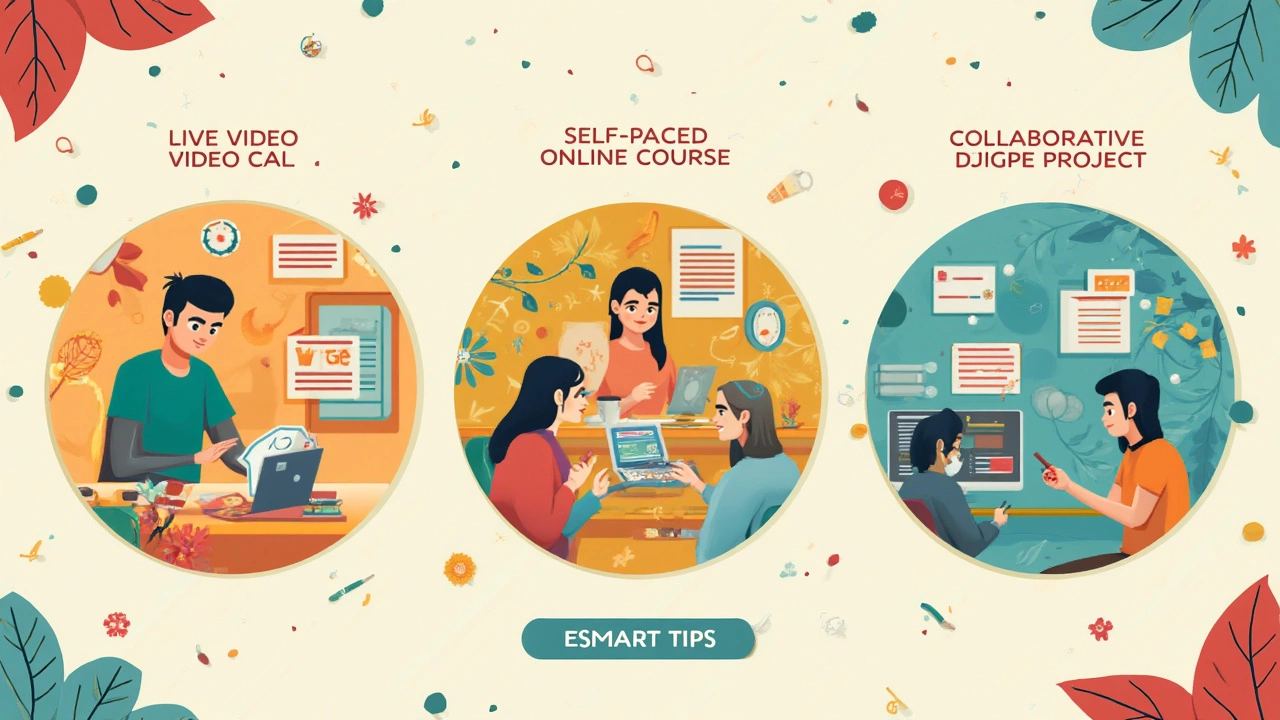Picture a classroom, but take away the walls and the desks. Now, add learners from everywhere, different time zones, different speeds, and almost any device you can think of. That’s what happens when eLearning steps in—suddenly, learning isn’t fixed to a bell schedule or a chalkboard. But eLearning isn’t just one thing. There are three major types, and knowing how each one ticks could totally change how you learn, teach, or even train a team. So, which one fits your world best? Stay tuned, because your choice might just be a game-changer.
Synchronous eLearning: Learning Together, Live
Synchronous eLearning is all about real-time, live interaction. Think Zoom school, virtual seminars, or a course that requires you to log in at the same time as everyone else. If you get energy from interaction, this kind of eLearning brings that in spades. It copies the feeling of a classroom through video calls, chats, and even breakout rooms. You’re not alone; you’re part of a living, breathing digital group. The biggest pro? Instant feedback. If you’re confused, you just ask. If you want to contribute, the digital ‘hand raise’ is right there. It’s a huge advantage, especially for topics where discussion and immediate clarification are a must.
But don’t think it’s perfect. Sometimes, wrangling everyone into the same digital space at the same time is tough. Time zones can be a nightmare. If you’re working a job, parenting, or just not a morning person, showing up live can become a real pain. Tech issues—bad Wi-Fi, broken mics—can crash the experience really fast. When Harvard moved to remote classes in 2020, some students noticed how attendance dropped and engagement fizzled the longer sessions went on. You can thank ‘Zoom fatigue’ for that. Still, when it works, synchronous eLearning offers killer group projects, lively debates, and a sense of connection you can’t fake.
Curious how businesses use it? Tons of corporate training now happens live online, saving money on travel and keeping teams updated, even if half the crew is remote. It’s also massive for global organizations. But if you need to work on your own schedule, think carefully—this one needs you to show up and be present, virtually.
Asynchronous eLearning: Learning on Your Own Terms
Not everyone operates on the same clock. That’s where asynchronous eLearning sweeps in. Here, you get to decide when and how fast you learn. The teacher uploads videos, quizzes, and assignments, and you go at your own pace. No scheduled logins. No livestreams. Just hit play and learn at midnight if that’s what works for you. This is the backbone of most online universities: Coursera, Udemy, Khan Academy—they love this style. According to a 2023 report, over 65% of online adult learners now pick courses offered asynchronously. Why? Flexibility. You control the pace, you review as often as you need, and you jump forward or back without waiting for anyone.
The downside? It’s lonely, and sometimes motivation slips. With nobody waiting on you to show up, procrastination sneaks in. Ever bought an online course and never finished it? You’re not alone—completion rates for self-paced courses on big platforms hover below 15%. Some people need deadlines and live check-ins to keep moving. If you love rewinding, reviewing, or processing complicated materials all by yourself, this style’s your best bet. Bonus tip: Set a regular schedule for yourself and build in rewards—like a coffee after finishing a unit—or join an online study group for some friendly peer pressure.
For companies, asynchronous learning often means compliance training videos, required HR policies, or onboarding modules. Employees do them when it suits, not on the clock. Want a quick stat? A Fortune 500 survey showed organizations using this style saved an average of $30,000 in training travel costs alone, while cutting downtime by 40%.

Blended Learning: The Best of Both Worlds
What if you don’t want to choose? Blended learning mixes live, synchronous elements with the independent flexibility of asynchronous learning. Imagine logging in once a week for a live seminar, then working through materials and assignments on your own time. It’s the magical combo that lets social butterflies and night owls both get what they want. Universities and companies love this approach. They might start with a face-to-face session to build rapport, move online for self-study, then regroup live to tackle challenges, discuss projects, or review tough concepts.
Data backs it up, too. A study from the U.S. Department of Education in 2022 found students in blended courses performed better, on average, than those in traditional classrooms or fully online environments. Why? Some people say it’s the mix of personal responsibility and guided support—the freedom to learn, plus the power of community.
- In-person learning for hands-on stuff, like lab work or team-building
- Asynchronous online for theory, reading, and self-paced mastery
- Live online check-ins for discussion and accountability
Lots of nurses, teachers, and engineers now train this way. Even Google’s own employee upskilling blends live Zooms with video modules. Pro tip: If you’re an employer, survey your team—some may prefer more live interaction, others want pure flexibility. Mix and match for best results.
Choosing the Right Type for You
Each type has its own rhythm. You might crave the energy of a live class, need the quiet focus of self-study, or want something smack in the middle. Ask yourself: Do you need structure? Go for synchronous or at least a regular blended routine. Do you juggle work, parenting, or unpredictable shifts? You’ll appreciate asynchronous freedom. Are you looking to build relationships or practice tough conversations? Live elements help. Learning languages, for example, works better with real-time speaking and listening practice, while tech courses on software are prime for pause-and-rewind sessions.
Here’s a table that breaks down the main advantages and drawbacks of each format:
| Type | Main Advantage | Main Drawback | Best For |
|---|---|---|---|
| types of elearning (Synchronous) | Live interaction, instant feedback | Less flexible scheduling | Group projects, discussions |
| Asynchronous | Work at your own pace, review materials | Lower engagement, risk of procrastination | Busy adults, self-motivated learners |
| Blended | Flexible structure, best of both worlds | Complex to organize | Corporate upskilling, universities |
Don’t forget to factor in your internet access, time zone, and personal preferences. Sometimes, what sounds efficient on paper falls apart if the tech doesn’t cooperate or if you lose motivation. Download materials when possible, keep a notebook for quick thoughts, and don’t be afraid to reach out for support if you get stuck—most eLearning platforms have forums or help desks, and even those can make a huge difference.

Power Tips for Making the Most of eLearning
Whichever route you pick, you can always get more from your study time by working smart. Here are some easy, tested hacks for every eLearning type:
- Synchronous tip: Treat it like a real class—turn your camera on, participate, and mute distractions. Give yourself a tech check before classes, and keep water nearby for those marathon sessions.
- Asynchronous tip: Block off specific study times in your calendar, and make friends with to-do lists. If you fall behind, don’t sweat it—just jump back in, and skip what you already know.
- Blended tip: Prep questions ahead of live sessions. Use asynchronous materials for deep dives, and tackle tricky points in group chats or office hours.
And here’s something wild: people who build social connections as they learn—whether it’s a WhatsApp revision group, a Slack channel, or just a buddy to message—tend to stick with their classes longer and get higher grades. So never underestimate the power of a simple ‘hi’ in the chat or a networking email after a virtual workshop.
So, what eLearning path fits your life right now? The answer might shift as jobs, goals, or family needs change. Stay flexible, test what clicks, and remember that the best learning tools aren’t just digital—they’re human curiosity, and a willingness to try.






Write a comment: